Table of contents
Our Understanding of Diamonds
Diamonds, the most precious of the five major gemstones, symbolize purity, loyalty, and eternal brilliance. They are the perfect representation of love, with diamond rings becoming the most important token of marriage. Diamonds also appreciate annually by 5%-10% or even more, making them a beloved luxury item.
However, because diamonds are valuable, people tend to be cautious when purchasing, comparing several options before deciding. But do you really know how to assess the quality of a diamond?
Diamond Grading
As widely known, the international diamond grading system is based on four factors, commonly referred to as the “4Cs“—Carat (weight), Clarity, Color, and Cut. By understanding these standards, consumers can greatly minimize the risk of being deceived. How exactly are diamonds evaluated? By learning the following, you can become a diamond expert yourself.
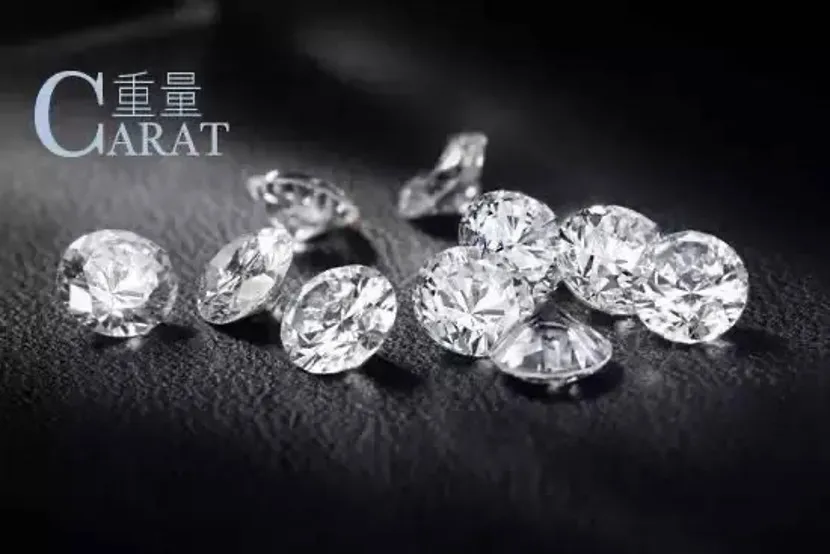
Carat: the unit of measurement for a diamond’s weight
The internationally recognized unit is “Carat,” often abbreviated as “ct.” Carat weight is one of the most easily measured characteristics of a diamond and is directly tied to its allure. With all other qualities being equal, the larger the diamond, the more valuable it becomes.
Furthermore, for jewelry purposes, a diamond must have a certain size and weight to fully exhibit its optical brilliance. Smaller diamonds, due to their limited size, often fail to display optimal brightness and are therefore commonly set in cluster designs to achieve a collective effect. Generally, diamonds over 0.30 carats can better showcase brightness, and for complete fire (dispersion of light), a diamond needs to weigh at least 0.70 carats. Thus, carat is the foundation of a diamond’s ability to display its beautiful optical effects.
During the cutting and polishing process, the normal loss rate for a diamond ranges from 50% to 75%, meaning the yield of a finished diamond is only 25%-50%. The scarcity of diamond resources, the rarity of large stones, and the low yield rate during production and processing all contribute to the high value of larger diamonds.
Weight Conversion
How much is 1 carat in grams? The current standard is 1 carat = 200 milligrams = 0.2 grams. Diamonds weighing less than 1 carat are often measured in “points” (abbreviated as “pt”). One carat equals 100 points, and a 0.75-carat diamond is also known as a 75-point diamond.
The “Carat Premium” Phenomenon
As a diamond’s grade increases, the effect of weight on its price becomes more significant, especially for diamonds near threshold weights. When other factors like color, clarity, and cut remain the same, the value of a diamond increases exponentially with weight, resulting in a price structure that jumps in steps.
Pricing
Diamond price = Carat weight squared × Base price per carat.
For diamonds at critical weights, there is a “carat premium” effect, where even a one-point difference can greatly impact price—for example, the price difference between a 99-point diamond and a 1-carat diamond can be substantial.
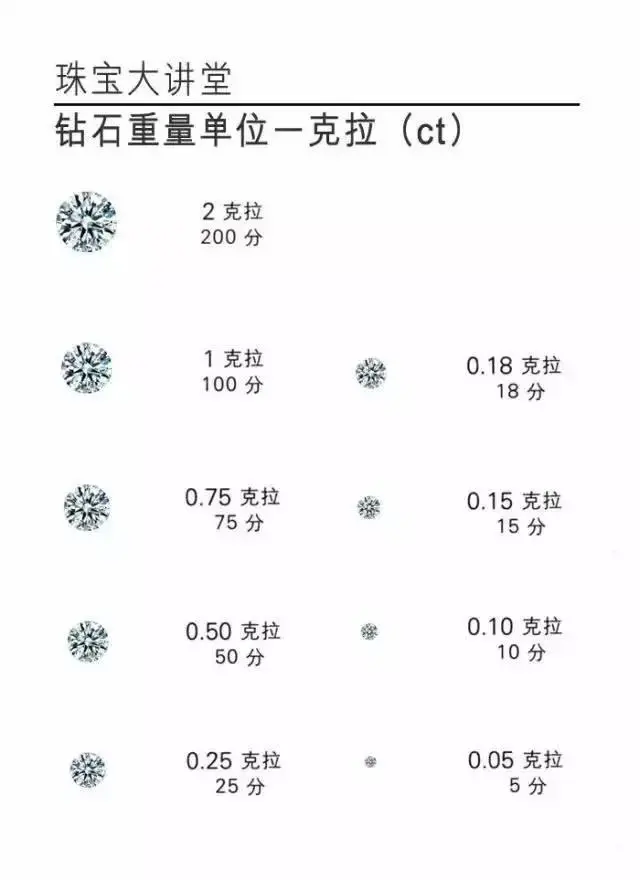
Standards for Diamond Weight Grading
According to the conventions in the diamond industry, diamonds weighing less than 0.05 carats are considered melee diamonds, those between 0.05 and 0.22 carats are small diamonds, those from 0.23 to 1 carat are medium diamonds, and diamonds over 1 carat are classified as large diamonds. Diamonds ranging from 10.8 to 50 carats are categorized as extra-large diamonds, while those exceeding 50 carats are termed “named diamonds.” Generally speaking, unless a diamond has a rare color or other unique features, only diamonds weighing over 100 carats qualify for entry into the world’s most famous diamonds.
Diamonds smaller than 0.2 carats are not graded according to national standards. Diamonds between 0.2 and 1 carat can be graded either as loose diamonds or mounted diamonds, while diamonds larger than 1 carat must be graded according to the standards for loose diamonds.
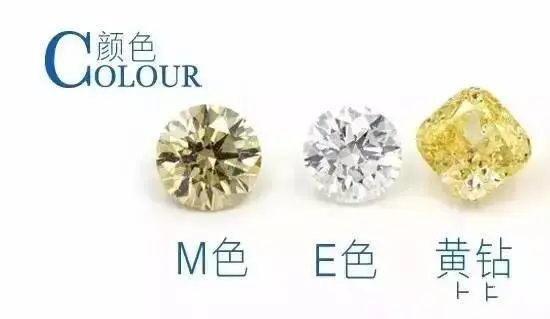
COLOUR: The innate beauty of diamonds
Diamonds can split light into a spectrum of colors and reflect these hues to create a dazzling display, acting like a colored lens that reduces excess reflected light. The lighter the color of the diamond, the stronger the flash of colors and the higher the color grade.
Diamonds are divided into two main categories: the colorless series and the colored series. Common colorless diamonds include colorless transparent, near colorless, and light yellow, while the colored series includes deep yellow, blue, pink, black, and others. The color grading system established by the Gemological Institute of America (GIA) ranges from “D” (colorless transparent, starting with the first letter of the word Diamond) to “Z” (light yellow-brown). Fancy colored diamonds exhibit an extraordinary array of colors and are extremely rare and costly; hence, the ordinary color grading system is not applicable to fancy colored diamonds.
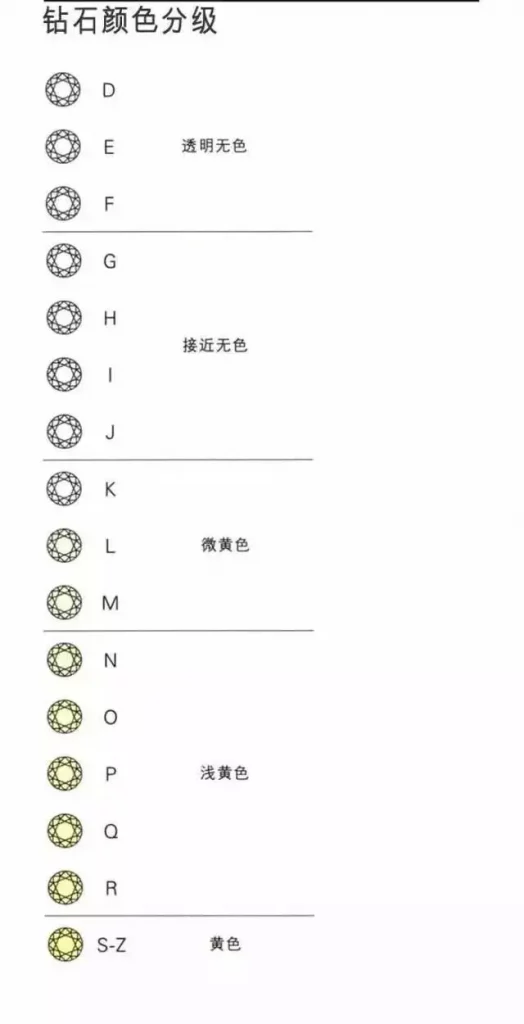
Diamonds graded D, E, and F are known as colorless and are exceptionally rare and valuable. The distinctions among them can only be discerned by experts. More commonly, diamonds graded G to J are considered near colorless and can be more easily identified by experts, although the perception may vary among the general public based on individual color discrimination. Diamonds graded K and below are referred to as light champagne color and are easier to identify, typically priced much lower.
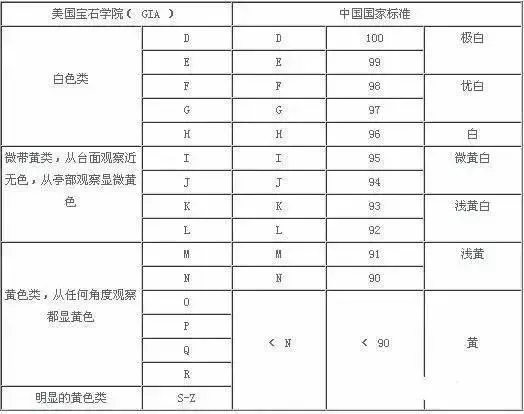
Gemological Institute of America (GIA)
GIA is the founder of the 4C diamond grading system, and diamond grading institutions worldwide use the GIA standards as a reference.
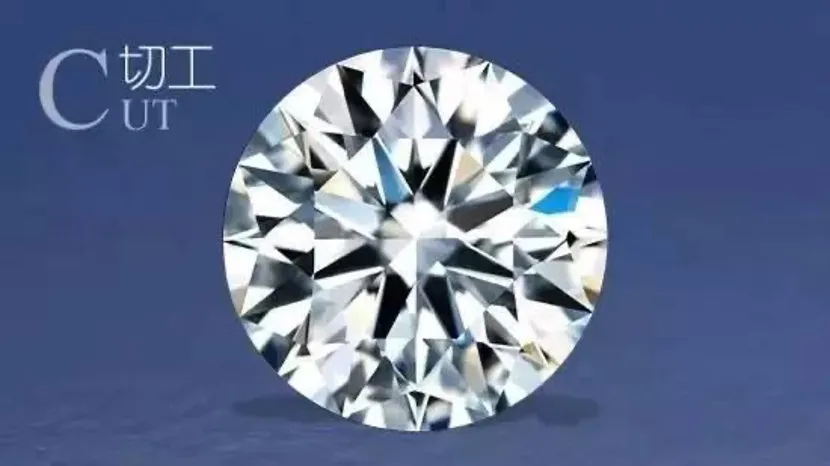
CUT: The cut of a diamond determines its brilliance and fire
The roundness, depth, width, and uniformity of facets significantly influence a diamond’s brightness. Many gemologists consider cut to be the most critical characteristic of a diamond because even if a diamond has perfect color and clarity, poor cutting can diminish its dazzling brilliance.
- Ideal Cut (EX): This standard is achieved by only 3% of top-quality diamonds. An ideal cut allows the diamond to reflect nearly all light entering it.
- Very Good Cut (VG): Approximately 15% of diamonds can achieve this level of cut. It allows the diamond to reflect light similarly to the standard cut but is priced slightly lower than ideal cuts.
- Good Cut (G): Around 25% of diamonds fall into this category. A good cut reflects most of the light entering the diamond, but it is priced much lower than the Very Good category.
- Fair Cut (F): About 35% of diamonds have a fair cut. They are considered acceptable diamonds, but the light reflection from fair cut diamonds is significantly inferior to that of good cut diamonds.
- Poor Cut (P): Diamonds graded as P have very poor cuts, significantly compromising their light reflection and refraction.
Cut also includes Polish and Symmetry.
- Polish: Polish enhances the brightness of a diamond. It is rated across five levels: EX > VG > G > F > P.
- Symmetry: Symmetry assesses the cutting symmetry of a diamond, including factors like roundness, table deviation, and depth deviation, rated as EX > VG > G > F > P.
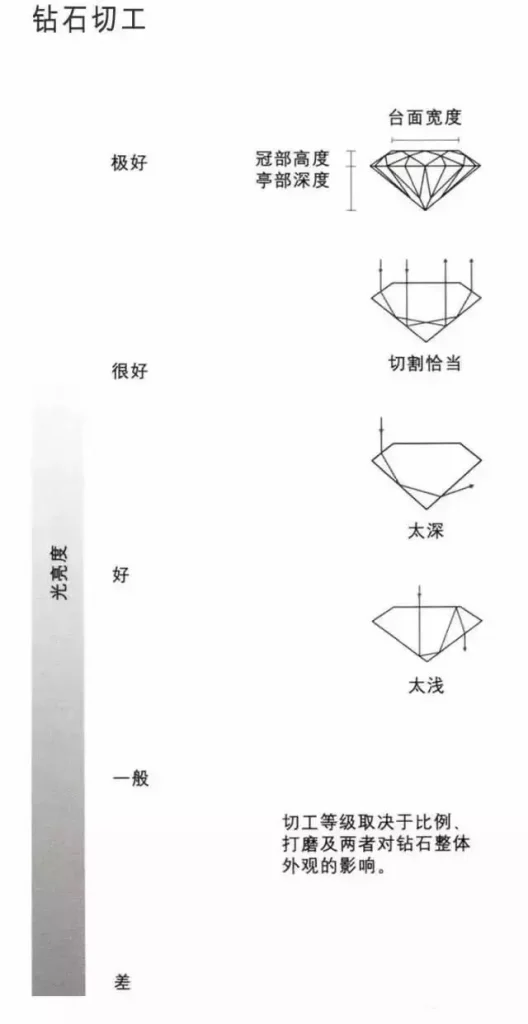
The best cut, polish, and symmetry (collectively known in the industry as “3EX perfect cut”) ensure that a diamond exhibits the best fire and showcases the perfect “Hearts and Arrows” effect.
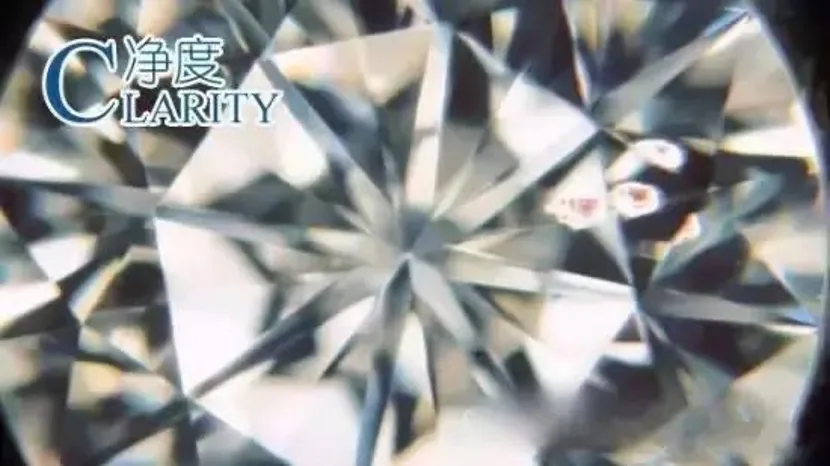
CLARITY: The natural blemishes of diamonds
Each diamond contains natural inclusions, akin to natural blemishes. The quantity, size, shape, color, and position of these inclusions determine a diamond’s clarity and uniqueness.
Clarity describes the degree of internal flaws in a diamond, graded by professionals under a 10x magnifying glass based on the size, number, and other factors of the inclusions. Flaws that affect diamond clarity are generally divided into two categories: internal flaws and surface flaws. Based on the visibility, type, quantity, and distribution of these flaws, diamonds can be classified into several grades:
- FL and IF Diamonds:
- FL (Flawless): No inclusions or blemishes visible under 10x magnification.
- IF (Internally Flawless): No inclusions visible under 10x magnification, but may have minor surface blemishes.
- VVS1 and VVS2 Diamonds:
- VVS1 (Very Very Small Inclusions): Contains extremely small inclusions that are very difficult to detect under 10x magnification.
- VVS2 (Very Very Small Inclusions): Similar to VVS1, with extremely small inclusions that are hard to notice under 10x magnification.
- VS1 and VS2 Diamonds:
- VS1 (Very Small Inclusions): Contains small inclusions that are challenging to observe under 10x magnification.
- VS2 (Very Small Inclusions): Contains small inclusions that are relatively easy to see under 10x magnification.
- SI1 and SI2 Diamonds:
- SI1 (Small Inclusions) and SI2 (Small Inclusions) contains noticeable inclusions that are easy to observe under 10x magnification.
- P Diamonds: P1, P2, and P3 diamonds have visible flaws to the naked eye and are typically used for industrial purposes.

What is F?
In the context of 4C+F, “F” stands for Fluorescence, which indicates the strength of a diamond’s fluorescence when exposed to ultraviolet light. Fluorescence refers to the blue or yellow light emitted by a diamond under intense ultraviolet light. Generally, this fluorescence is not visible in normal lighting conditions, but in strong sunlight, diamonds with strong fluorescence can exhibit noticeable fluorescence. While fluorescence does not affect the wearability of the diamond, it significantly impacts its price.
The GIA grading for fluorescence includes five levels: N (None), F (Faint), M (Medium), S (Strong), and VS (Very Strong).

The Principle of Fluorescence
The principle of fluorescence involves diamonds emitting light when exposed to ultraviolet light due to nitrogen atom impurities. The ultraviolet energy absorbed by the diamond is re-emitted at lower energy levels or longer wavelengths, creating a blue fluorescence. This fluorescence is not radioactive and poses no health risks.
Fluorescence’s Impact on Diamond Prices
Fluorescence can influence diamond prices; diamonds with fluorescence are generally cheaper than those without. The fluorescence grade can significantly affect the prices of diamonds graded D-G, especially those over 0.5 carats with a VS grade or higher. Generally, faint fluorescence can reduce the price by about 5%, medium fluorescence by approximately 7%-10%, and strong fluorescence can impact higher color diamonds even more, potentially reducing prices by up to 30% or more. Diamonds with very strong fluorescence may be priced about 35% lower than those without fluorescence. This effect is particularly pronounced in D, E, and F color diamonds weighing 1-2 carats. Strong fluorescence can create a hazy effect on near-colorless diamonds (more apparent under a 10x magnifier), impacting their transparency. For diamonds graded below J color, while fluorescence may enhance whiteness, the price may still be lower by 5%-10%. For diamonds graded M color, fluorescence has little effect on pricing. Small diamonds under 0.2 carats are also minimally impacted, while diamonds between 0.2 and 0.5 carats with high clarity (VVS) may still experience some price effects.
How to Choose Diamonds with Good Cost-Performance Ratios
It is recommended to choose diamonds with colors F, G, and H (colorless to near colorless) and clarity at the VS level (slight inclusions). Diamonds within this range offer above-average parameters and are excellent choices for engagement rings or anniversary gifts, providing great value. Non-professionals may struggle to distinguish the subtle differences between “colorless” and “near colorless” or between “flawless” and “slightly included,” often perceiving them as high-grade diamonds.
